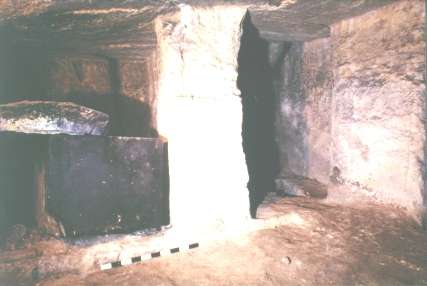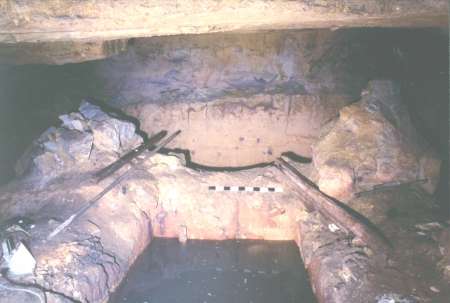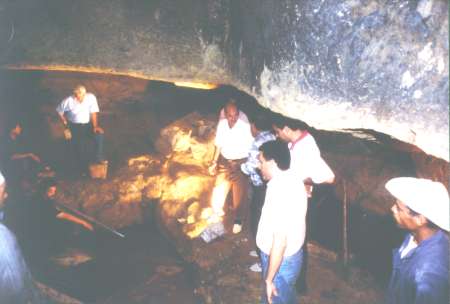
The second level of the Osirion at Giza showing a granite sarcophagus inside a niche (left)

The second level of the Osirion at Giza showing a granite sarcophagus inside a niche
(left)
The Osiris Shaft is located under the causeway of Khafre, and it is about 25 feet deep. In ancient times people used the water-filled shaft as a swimming-hole, and even to the present day many people, including archaeologists, have entered the shaft. For centuries, however, the meaning of the Osiris Shaft has escaped even the most learned scholars.
This "water shaft" is already the stuff of legend and Internet rumor. It opens in the causeway linking the Sphinx to the second pyramid, and it descends in several places to a depth of nearly 100 feet below the plateau. 'The shaft received its name from the crystal-clear water that fills its bottom chamber. This unfinished water-filled cavern is entered from a higher chamber that contains niches filled with granite stone coffins. One of the empty niches contains a shaft in its floor that leads to a flooded corridor. Wading into the darkness, one can hear the echoes of ground water dripping from the rock walls.
I decided to investigate this shaft last year. Excavation of the second level revealed six rooms cut into the rock; the rooms contained two granite sarcophagii, pottery, and bones. Analysis of the pottery and bones dated this level to 500 BC.
The last level we excavated was about 25m underground, and it was completely filled with water. We stayed for two months draining the water from the shaft and working inside it, and I felt I might and up blind and deaf from all of the dust, mud, and noise of the water! This was the most difficult excavation I was ever involved with.

The third level of the Osirion
After the excavation, I looked down into the water and saw the -remains of four pillars surrounded by a wall. Inside them was part of a large, granite sarcophagus with the lid thrown off. This discovery reflected the words of Herodotus when he said that Cheops was buried inside a granite sarcophagus and there was water near Cheops pyramid. People have always wondered about these words, but no one ever discovered the exact location. Even Herodotus admitted that he never saw the burial with his own eyes,
because he would never be able to go down into the shaft. He must have based his writing on the words of guides.
The Egyptian Expedition directed by Zahi Hawass during the excavation of the
third level.
I made my second discovery from this excavation after moving the lid of the sarcophagus. I found inscribed in the ground the hieroglyphic word "pr", meaning "house." It is known that the Giza plateau was called "pr wsir nb rstaw", or "the house of Osiris, Lord of Rastaw." "Rastaw" refers to the underground tunnels, and most likely the name of the plateau reflects the tunnels inside the Osiris Shaft. The final chamber we found was most likely a symbolic tomb for the god Osiris; he was believed to control the underground tunnels and tombs of the kings.
In the Late period, the Egyptians cut a tunnel about 6m long on the west wall of the shaft. We sent a boy through the tunnel, only to find that it is closed of and does not lead to any more chambers. To derive the date of the shaft, a boy was lowered into the water-filler tomb on a rope to collect artifacts. From the objects retrieved, we dated the shaft to the New Kingdom, 1550 BC.
Dr. Zahi Hawass Director of the Giza Pyramids and Saqqara